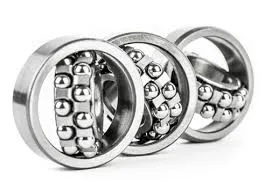
dec . 23, 2024 09:27 Back to list
Understanding the Function and Applications of Radial Thrust Ball Bearings in Machinery
The Importance of Radial Thrust Ball Bearings in Modern Engineering
Radial thrust ball bearings are essential components in various mechanical systems, playing a crucial role in ensuring efficient operation and minimizing wear and tear on machinery. These specialized bearings are designed to support radial loads while allowing for the accommodation of axial forces. Understanding their structure, functionality, and applications can significantly enhance our appreciation of their importance in modern engineering.
Structure and Functionality
Radial thrust ball bearings consist of several key components an inner and outer ring, balls, and a cage. The inner ring typically fits onto the rotating shaft, while the outer ring is attached to the stationary housing. The balls are positioned between the two rings, and the cage helps maintain their spacing, ensuring even distribution of load and minimizing friction.
The primary function of these bearings is to facilitate rotation while simultaneously supporting both radial (perpendicular to the axis of rotation) and axial (along the axis of rotation) loads. This dual capability makes them particularly valuable in applications where both types of forces are present. For instance, in electric motors, radial thrust ball bearings enable smooth rotation while supporting the weight of the rotor and other attached components.
Applications
Radial thrust ball bearings are commonly used in various applications across multiple industries. In the automotive sector, they are found in engines, transmissions, and wheel hubs, ensuring smooth operation and reliable performance. Their ability to handle dual loads allows for more compact designs, contributing to the overall efficiency of vehicles.
In manufacturing, these bearings are integral to conveyor systems and robotics, where precision movement and load management are critical. Additionally, in the field of aerospace, radial thrust ball bearings are employed in aircraft engines and critical flight components, where safety and reliability are paramount.
Advantages
radial thrust ball bearing

The advantages of radial thrust ball bearings can be attributed to their design and functionality
. They provide low friction, which translates into reduced energy consumption and improved efficiency. Furthermore, the ability to withstand both radial and axial loads means that machinery can be designed with fewer components, leading to lighter and more compact systems.Moreover, the materials used in manufacturing these bearings, such as high-grade steel or ceramic, contribute to their durability and resistance to wear, ensuring a longer lifespan and lower maintenance costs. This robustness is particularly vital in applications subject to harsh environments, such as industrial machinery exposed to dust, dirt, and moisture.
Challenges
Despite their many benefits, radial thrust ball bearings are not without challenges. One significant issue is the potential for misalignment, which can lead to uneven wear and reduced performance. Proper installation and regular maintenance are essential to mitigate this risk. Additionally, while they are efficient under load, their performance can be affected by speed limits. Exceeding these limits can result in overheating and premature failure.
Future Trends
As technology advances, the design and materials used in radial thrust ball bearings continue to evolve. Innovations such as advanced lubrication systems, hybrid bearings combining ceramic and steel materials, and improved manufacturing techniques are enhancing their performance and longevity. Moreover, the push for increased efficiency in various industries is driving the development of specialized bearings tailored to meet specific operational requirements.
Conclusion
In conclusion, radial thrust ball bearings are a vital component in modern engineering, providing essential support for both radial and axial loads across various applications. Their efficient design, combined with the ongoing advancements in technology, ensures they remain a cornerstone in the machinery of today and the future. As industries continue to evolve, the role of these bearings will likely expand, underscoring their importance in achieving greater efficiency and reliability in mechanical systems. Understanding their function and applications is critical for engineers and manufacturers aiming to innovate and optimize performance in an increasingly demanding landscape.
Latest news
-
Common Failures in Thrust Ball Bearings and Solutions
NewsAug.22,2025
-
How Tapered Roller Bearings Can Take Shock Loads
NewsAug.22,2025
-
Angular Bearings in High-Precision Spindles
NewsAug.22,2025
-
The Impact of Misalignment on Cylindrical Roller Bearing Performance
NewsAug.22,2025
-
The Role of Cage Design in Deep Groove Ball Bearing Durability
NewsAug.22,2025
-
The Impact of Material Quality on Machinery Bearings’ Lifespan
NewsAug.22,2025
